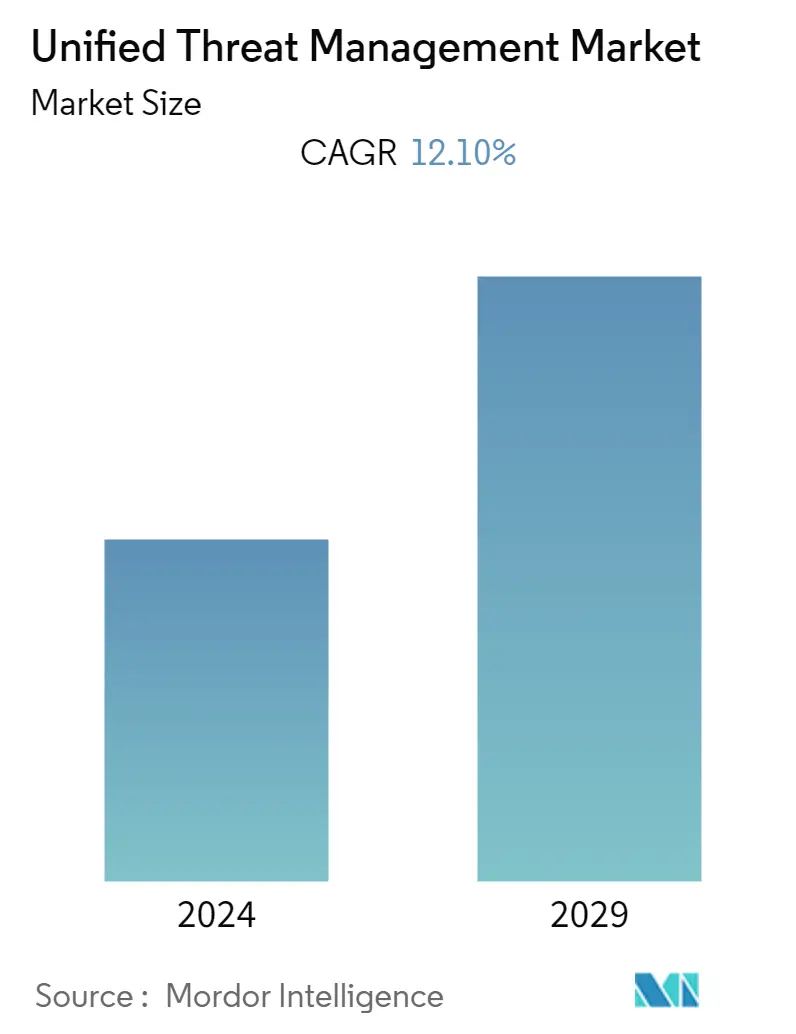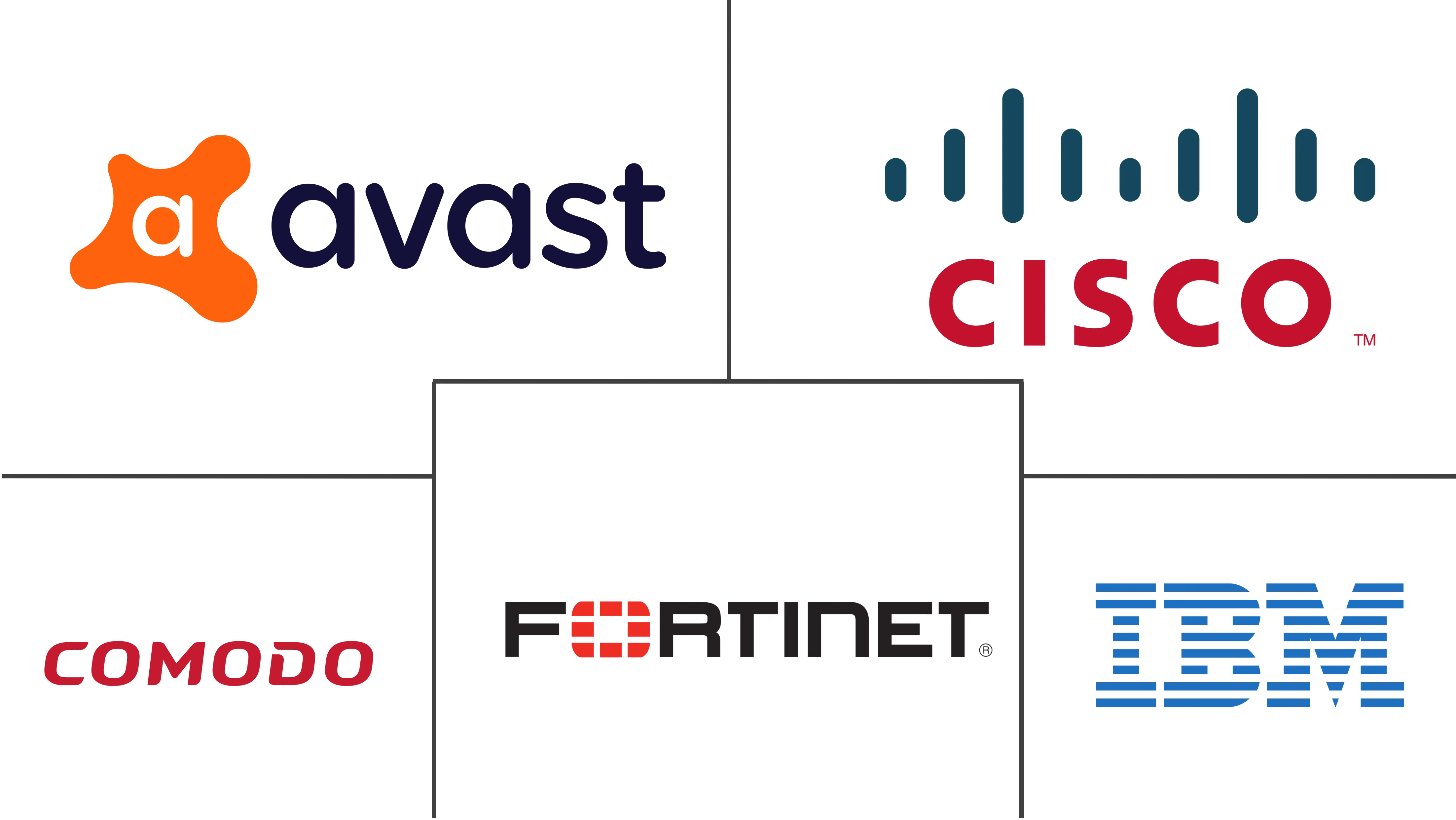Market Size of Unified Threat Management Industry

| Study Period | 2019 - 2029 |
| Base Year For Estimation | 2023 |
| CAGR | 12.10 % |
| Fastest Growing Market | Asia-Pacific |
| Largest Market | North America |
| Market Concentration | Medium |
Major Players
*Disclaimer: Major Players sorted in no particular order |
Unified Threat Management Market Analysis
The Unified Threat Management Market is expected to register a CAGR of 12.10% over the forecast period. Demand for UTM is rising as IT businesses prioritize protecting corporate networks from threats. Enterprises of all sizes use UTM solutions to lessen the risk of such attacks and simplify management.
- With features including network firewalls, gateway antivirus, gateway anti-spam, VPN, load balancing, data leak prevention, content filtering, and on-appliance reporting, Unified Threat Management (UTM) is a comprehensive security solution with enormous value to businesses. Over the past ten years, there has been a growth in demand for UTM solutions and services due to consolidating all such security capabilities onto a single appliance. Due to its many advantages, including low cost, ease of deployment, and configuration, small businesses were once the primary end users of unified threat management. However, today's enterprises are also adopting UTM solutions because of their scalable and agile features, which can lower energy consumption and increase IT productivity.
- A few main reasons for the rise in demand for UTM solutions include increased data breaches, regulatory compliance, assistance from cutting-edge technology, and the ability to offer increased value to enterprises. In the upcoming years, it is anticipated that the market for unified threat management will experience tremendous expansion.
- Solutions for unified threat management offer numerous benefits in terms of efficiency and integration. The UTM solution has historically been less practical for applications demanding consistent and high network throughput due to the decrease in performance features caused by consolidating multiple security tools into a single network device. This obstacle prevented the Unified Threat Management market from taking off in big businesses. Vendors are now continuously improving the quality and quantity of their solution offerings to meet this challenge and maintain them in line with the needs of large organizations.
- Currently, UTM centralized consoles are used by larger firms' various branch offices to provide security for a whole infrastructure. This eliminates the need to manage individual sites or gateways, which lowers administrative expenses and mistakes.
- Since the COVID-19 epidemic broke out, and since then, there has been a rise in UTM adoption across the board. The need for unified threat management in healthcare has grown along with the exponential increase in COVID-19 patients, hospital admissions, and the greater use of digital health services like electronic medical records (EMR). The demand for unified threat management implementation is increasing due to the increase in online and digital transactions worldwide. The increased use of IT services amid lockdown limitations and work-from-home regulations has increased demand for UTM.
Unified Threat Management Industry Segmentation
A security management strategy called unified threat management is utilized to supply integrated platforms, infrastructure, and security-related applications. Additionally, UTM systems provide enterprises with numerous benefits like cost-effectiveness, an integrated strategy, regulatory compliance, simplicity, and a decreased need for technical training. As a result, UTM benefits are anticipated to assist organizations in reducing threats like cybercrime, data loss, and other incidents that typically occur in enterprises, which is expected to fuel the expansion of the UTM market.
The Unified Threat Management is Segmented by Component (Hardware, Software, Virtual), By Service (Professional Service, Managed Service), Distribution Channel (Direct Sales, Value-Added Resellers (VARS), Distribution), By End-User (BFSI, IT & Telecom, Healthcare, Retail, Manufacturing, Utilities, Transport, Other), Geography (North America, Europe, Asia Pacific, Latin America, and Middle East & Africa).
The market sizes and forecasts are provided in terms of value (USD million) for all the above segments.
Unified Threat Management Market Size Summary
The Unified Threat Management (UTM) market is experiencing significant growth as businesses increasingly prioritize the protection of corporate networks from cyber threats. UTM solutions, which integrate various security features such as firewalls, antivirus, anti-spam, VPN, and data leak prevention into a single appliance, offer substantial value by simplifying management and reducing costs. Initially favored by small businesses due to their affordability and ease of deployment, UTMs are now gaining traction among mid-sized and large enterprises. This shift is driven by the need for scalable and agile security solutions that can enhance IT productivity and reduce energy consumption. The rising incidence of data breaches, regulatory compliance requirements, and advancements in technology are further propelling the demand for UTM solutions across various sectors.
The market is characterized by intense competition, with numerous players offering a range of products and services to meet the diverse needs of businesses. North America, in particular, is witnessing robust growth due to its expanding cloud security infrastructure and the high frequency of cyberattacks, which have led to widespread UTM adoption. The presence of leading UTM service providers in the region is also contributing to market expansion. Key strategies employed by major players include product innovation and strategic partnerships, aimed at enhancing performance and addressing user demands. As organizations continue to generate vast amounts of data, the need for effective security solutions like UTMs is becoming increasingly critical, driving the market's upward trajectory.
Unified Threat Management Market Size - Table of Contents
-
1. MARKET INSIGHTS
-
1.1 Market Overview
-
1.2 Industry Attractiveness-Porter's Five Force Analysis
-
1.2.1 Bargaining Power of Suppliers
-
1.2.2 Bargaining Power of Buyers/Consumers
-
1.2.3 Threat of New Entrants
-
1.2.4 Threat of Substitute Products
-
1.2.5 Intensity of Competitive Rivalry
-
-
1.3 Impact of COVID-19 on the Market
-
Unified Threat Management Market Size FAQs
What is the current Unified Threat Management Market size?
The Unified Threat Management Market is projected to register a CAGR of 12.10% during the forecast period (2024-2029)
Who are the key players in Unified Threat Management Market?
Avast Software s.r.o., Cisco Systems, Inc, Comodo Security Solutions, Fortified Networks and IBM are the major companies operating in the Unified Threat Management Market.

